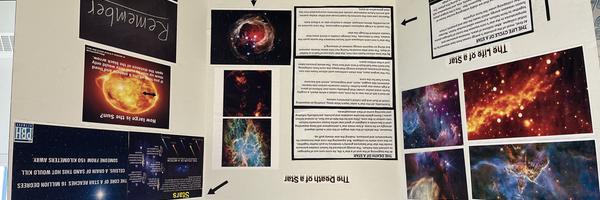How Stars Are Made
Grade 6
Presentation
No video provided
Problem
How Stars Are Made
Method
I got most of my Information from [NASA STARS] and the key words to remember from google.
Research
How Stars are Made
Birth of Stars
THE BIRTH OF A STAR [WEBSITE NASA STARS]
Stars form in large clouds of gas and dust called molecular clouds. Molecular clouds range from 1,000 to 10 million times the mass of our own Sun and can span as much as hundreds of light-years. Molecular clouds are cold which causes gas to clump up, creating high-density pockets. Some of these clumps can interact with each other or collect more matter, strengthening their gravitational force as their mass grows.
Eventually, gravity causes some of these clumps to collapse. When this happens, friction causes the material to heat up, which eventually leads to the development of a protostar – a baby star. Batches of stars that have recently formed from molecular clouds are often called stellar clusters, and molecular clouds full of stellar clusters are called stellar nursery Stars form in large clouds of gas and dust called molecular clouds. Molecular clouds range from 1,000 to 10 million times the mass of our own Sun and can span as much as hundreds of light-years. Molecular clouds are cold which causes gas to clump up, creating high-density pockets. Some of these clumps can interact with each other or collect more matter, strengthening their gravitational force as their mass grows.
THE LIFE CYCLE OF A STAR
At first, most of the protostar’s energy comes from heat released by its initial collapse. After millions of years, immense pressures and temperatures in the star’s core squeeze the nuclei of hydrogen atoms together to form helium, a process called nuclear fusion. Nuclear fusion releases energy, which heats the star and prevents it from further collapsing under the force of gravity.
Astronomers call stars that are stably undergoing nuclear fusion of hydrogen into helium a Main Sequence Star . This is the longest phase a star will go thruogh. The star’s luminosity, size, and temperature will slowly change over millions or billions of years during this phase. Our Sun is roughly midway through its own main sequence stage.
THE DEATH OF A STAR
At the beginning of the end of a star’s life, its core runs out of hydrogen to convert into helium. The energy produced by fusion creates pressure inside the star that balances gravity’s tendency to pull matter together, so the core starts to collapse. But squeezing the core also increases its temperature and pressure, making the star slowly puff up.
However, the details of the late stages of the star’s death depend strongly on its mass. A low-mass star’s atmosphere will keep expanding until it becomes a subgiant or giant star while fusion converts helium into carbon in the core. (This will be the fate of our Sun, in several billion years.) Some giants become unstable and pulsate, periodically inflating and ejecting some of their atmospheres.
Eventually, all the star’s outer layers blow away, creating an expanding cloud of dust and gas called a planetary nebula.
All that’s left of the star is its core, now called a white dwarf, a roughly Earth-sized stellar cinder that gradually cools over billions of years. A high-mass star goes further. Fusion converts carbon into heavier elements like oxygen, neon, and magnesium, which will become future fuel for the core.
For the largest stars, this chain continues until silicon fuses into iron. These processes produce energy that keeps the core from collapsing, but each new fuel buys it less and less time. The whole process takes just a few million years.
By the time silicon fuses into iron, the star runs out of fuel in a matter of days. The next step would be fusing iron into some heavier element but doing so requires energy instead of releasing it.
The star’s iron core collapses until forces between the nuclei push the brakes, then it rebounds. This change creates a shock wave that travels outward through the star.
The result is a huge explosion called a supernova. The core survives as an incredibly dense remnant, either a neutron star or a black hole.
Material cast into the cosmos by supernovae and other stellar events will enrich future molecular clouds and become incorporated into the next generation of stars.
Fun Facts:
- 1 OUR GALAXY KNOWN AS THE MILKY WAY,CONTAINS A ESTIMATED 200 TO 400 BILLION STARS.
- 2 THE FASTEST SPINNING STAR EVER DISCOVERED, VFTS 102, ROTATES AT 1.6 MILLION KMPH.
- 3 A ZOMBIE STAR IS A SURVIVING FRAGMENT OF STAR THAT EXPODED.
- 4 THE STAR VY CAINS MAJORIS IS SO MASSIVE A PLANE WOULD TAKE MORE THAN A THOUSAND YEARS TO ORBIT IT.
- 5 MOST STARS YOU SEE IN THE NIGHT SKY ARE ACTUALLY TWO STAR SYSTENS, OR BINARY STAR SYSTEMS .
- 6 THEY ARE SO FAR AAY HOWEVER THAT THEY JUT APPEAR AS ONE SPECK OF LIGHT.
- 7 STARS HAVE DIFFERENT COLORS BASED ON TEMPERATURE.
KEY WORDS TO REMEMBER
BIRTH
1.NEBULA: - A large cloud of gas and dust where stars are born.
2.PROTOSTAR: - A warm clump of molecules that forms when particles in a nebula collide.
KEY WORDS TO REMEMBER
LIFE
3.MAIN SEQUENCE STAR : - The longest stage of a star’s life, when it burns hydrogen fuel at a steady rate.
4.RED GIANT: - A stage when a star begins to run out of hydrogen fuel.
DEATH
WHITE DWARF: - The core of a low-mass star after I has expelled its outer layers.
NEUTRON: - The remains of a high-mass star after it explodes in a supernova.
BLACK HOLE: - The final stage of a massive star’s life.
Data

